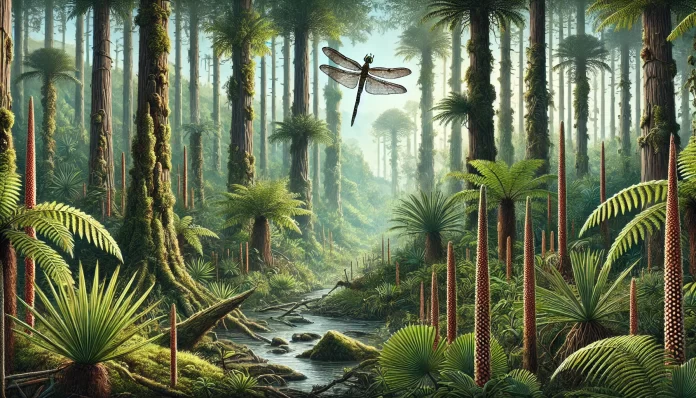The Carboniferous Period (359 to 299 million years ago) was a transformative time in Earth’s history, particularly for plant life. During this era, plants reached new heights—both figuratively and literally—as vast swampy forests dominated the landscape. These ancient ecosystems were pivotal not only for their sheer scale and diversity but also for their role in shaping the planet’s climate and geology.
The Lush Forests of the Carboniferous
The warm, humid climate of the Carboniferous created perfect conditions for the growth of vast lowland forests. These forests were unlike anything we see today, dominated by primitive plant groups that thrived in waterlogged environments.
Lycophytes: The Giants of the Swamp
The lycophytes, such as Lepidodendron and Sigillaria, were some of the most iconic plants of this period. These ancient relatives of modern club mosses reached towering heights of up to 30 meters. Unlike modern trees, their trunks were covered in scaly bark, and their reproduction depended on spores rather than seeds.
Horsetails and Calamites
Horsetails (Equisetum), which today are small and inconspicuous, were represented by giant relatives like Calamites during the Carboniferous. These plants formed dense thickets along riverbanks, with hollow, jointed stems that could grow over 10 meters tall.
Ferns and Seed Ferns
Ferns were abundant in the Carboniferous forests, with sprawling fronds that created a lush, canopy-like layer. Alongside true ferns were seed ferns (Pteridosperms), an extinct group of plants that combined fern-like foliage with seeds. These plants were a significant evolutionary step, bridging the gap between spore-reproducing plants and the seed-bearing gymnosperms that would later dominate.
Cordaites: The Early Gymnosperms
Cordaites, an ancestor of modern conifers, was one of the first gymnosperms to appear during the Carboniferous. These trees grew in drier upland areas, producing seeds rather than spores, which allowed them to thrive in less swampy conditions. This adaptation foreshadowed the dominance of gymnosperms in later geological periods.
Plant Evolution and Adaptations
The Carboniferous Period was a time of significant evolutionary advancements for plants, particularly in reproduction and structural adaptations.
The Development of Spores and Seeds
Most plants in the Carboniferous reproduced via spores, which required water for fertilization. However, the appearance of early seed plants during this time was revolutionary. Seeds allowed plants to colonize drier habitats, as they could protect the developing embryo from desiccation and provided a food source for early growth.
The Rise of Lignin and Wood
Plants of the Carboniferous developed thickened vascular tissues containing lignin, a compound that provided structural support and allowed them to grow taller than ever before. This innovation enabled the formation of towering forests and opened up new ecological niches for other organisms.
The Carboniferous Contribution to Modern Coal
The dense forests of the Carboniferous were crucial in shaping the Earth’s geological history. When plants died in the swampy, oxygen-poor environments, their remains were buried under layers of sediment. Over millions of years, this organic material was compressed and transformed into coal. Today, the coal deposits from the Carboniferous fuel industries worldwide, earning this period its name, meaning “coal-bearing.”
The Decline of the Carboniferous Forests
Towards the end of the Carboniferous, the climate began to cool, and glaciers formed in the southern hemisphere. The once-vast swamps shrank, leading to the decline of many plant groups that relied on waterlogged conditions. However, plants that could survive in drier climates, such as gymnosperms, began to rise in prominence, setting the stage for the ecosystems of the Permian Period.
Legacy of Carboniferous Plants
The plants of the Carboniferous were ecological pioneers. They created the first true forests, shaped the planet’s atmosphere by sequestering carbon, and laid the groundwork for modern terrestrial ecosystems. Many of their evolutionary innovations, from vascular tissues to seeds, continue to influence plant life today.
Understanding these ancient forests helps us appreciate the complexity and resilience of plant life, as well as the profound impact plants have had on shaping Earth’s history. The Carboniferous Period stands as a testament to the transformative power of the plant kingdom.




